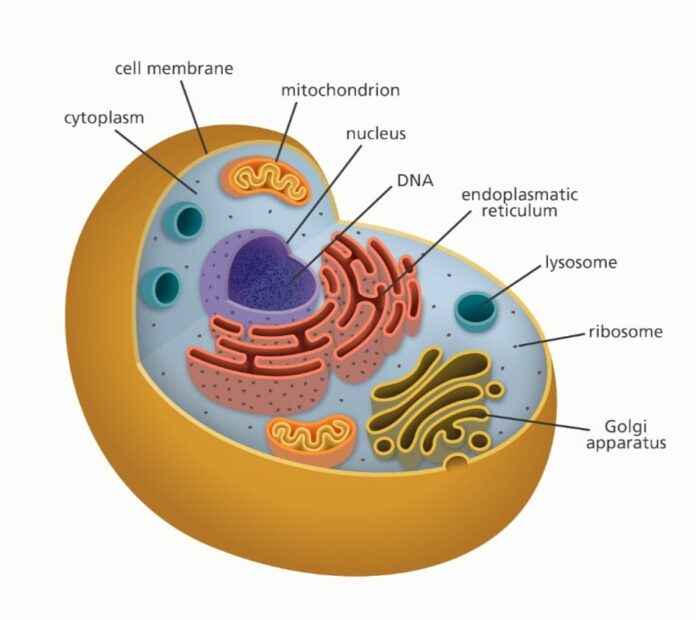Cell
- All living forms are composed of microscopic units called as ‘Cells’.
- A cell is the basic structural and functional unit of all life forms.
- Study of structure and composition of cell is called Cytology’.
Discovery of Cell
- Cell was first discovered and observed by Robert Hooke in a thin dead slice of cork in the year 1665.
- First free living cell was discovered by A. V. Leeuwenhoek. in 1674.
Cell Formation
Protoplasm is an aggregate of various chemicals such as water, ions, salts and other organic molecules like proteins, carbohydrates, fats, nucleic acids, vitamins etc. along with cell organelles & nucleus that constitute a cell. It exists in sol-gel states.
The Cell Theory
- A cell is the structural and functional unit of all living organisms.
- All living organisms are made up of cells.
- Cells are formed from pre-existing cells.
Type of Cells: On the Basis of type of organization, cells are of two kinds-
- Prokaryotic Cells
- Eukaryotic Cells
Prokaryotic Cells:
- Very minute in size. (1 to 10⁻⁶ m)
- Nuclear region (nucleoid) not surrounded by a nuclear membrane.
- Always Unicellular
- Single Chromosome present.
- Nucleolus absent.
- Cell division by fission or budding
- Membrane bound cell organelles are absent.
- Example- Bacteria
Eukaryotic Cells:
- Fairly large in size. (5-100 μm)
- Nuclear material surrounded by a nuclear membrane.
- May be unicellular or multicellular.
- More than one chromosome present.
- Nucleolus present.
- Cell division by mitosis or meiosis.
- Membrane bound cell organelles are present.
- Example- All Plants, Animals, Amoeba etc.
Type of Organism
Organism are of two Type:
- Unicellular organism- These organisms are single celled which perform all the functions. Example: Amoeba, paramecium, bacteria.
- Multicellular organism- Many cells grouped together to perform different function in the body and also form various body parts. Example: fungi, plants, animals.
The Shape of the Cell
- The shape of the cell may vary depending upon the type of function they perform in an organism.
- Cells are capable of changing their shape. For example, the white blood cells and amoeba can change shapes on their own.
- Generally cells are spherical but they may be elongated (nerve cell), branched (pigmented), discoidal (RBC). Spindle- shaped (muscle cell) etc.
Cell Size
- Size of cell is variable depending upon the its position & function Some are microscopic while some are visible with naked eyes. Their size may vary from 0.2um to 18 cm.
- Size of typical cell in a multicellular organism ranges from 2-120 micron.
- The largest cell is ostrich Egg (15 cm long 13cm wide & weight 1.4 kg)
- The longest cell is nerve cell (upto 1m).
- Smallest cells so far known are PPLOS e.g., mycoplasma
Components of Cell
There is an occurrence of division of labour within a Eukaryotic cell as they all got certain specific components called ‘Cell organelles’. Each of them perform a specific function.
The three basic components of all the cells are:
- Plasma membrane
- Nucleus
- Cytoplasm
Cell Membrane/Plasma Membrane
- Plasma membrane is selectively permeable in nature, means it allows or permits the entry and exit of some materials in and out of the cell.
- Cell membrane is also called plasma membrane or plasma lemma.
Properties of Plasma membrane
- It is the limiting boundary of each cell which separates cytoplasm from its surroundings.
- It is found in both plant as well as animal cells.
- It is the outermost covering of a cell in case of animals and lies below the cell wall in case of plants.
- As per the liquid model of plasma membrane. It is made up of proteins and lipids where proteins are sandwiched between bilayer of lipids.
- Singer and Nicholson gave the fluid mosaic model or liquid – bilayer model of plasma membrane.
- It is flexible and can be folded, broken and reunited.
Functions of Plasma Membrane
- It regulates the movement of molecules inside and outside the cell.
- It helps in maintaining the distinct composition of the cell.
Transportation of molecules across the Plasma Membrane:
This can be done by following ways:
- Diffusion:
Movement of solutes or ions from a region of higher concentration to a region of lower concentration is called as diffusion. It does not require energy therefore, itis called as passive transport.
- Osmosis:
The movement of solvent or water from its higher concentration (solvent) to lower concentration (solvent) through a semipermeable membrane is called as osmosis.
Osmosis can also be called as ‘Diffusion of solvents’.
- Endomosis:
Movement of solvent into the cell is called Endomosis.
- Exosmosis:
Movement of solvent outside the cell is called Exomosis.
Cell Wall
- It is the outermost covering of the plant cells and cells of fungi.
- It is absent in animal cells.
- Cell wall is rigid, strong, thick porous and non-living structure. In plant it is made up of cellulose and hemicelluloses. In fungi it is primarily made up of Chitin. Cell walls of two adjacent cells are joined by a layer called middle lamellae and microscopic channels called plasmodesmata for transport.
Functions of Cell Wall
- It provides definite shape, structure, support and protection to the cell.
- It provides strength to the cell.
- It is permeable and allows entry of molecules of different sizes & thus control intercellular Transport.


































